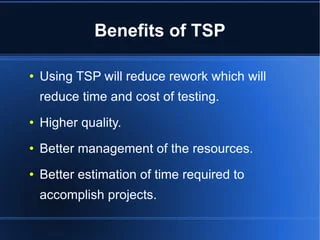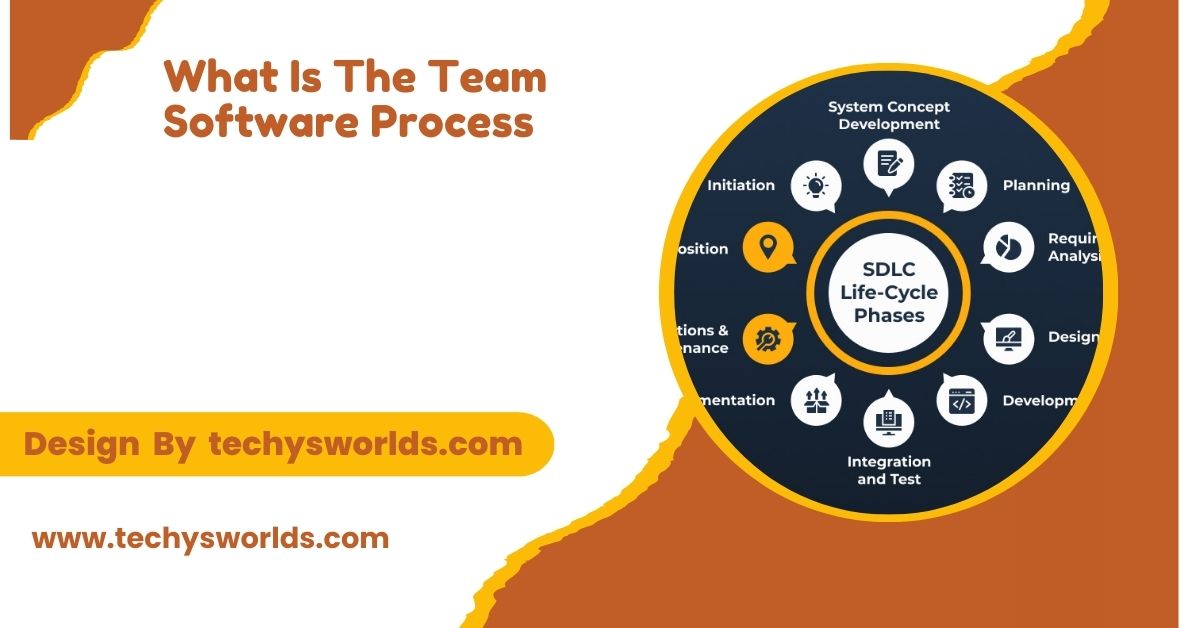The Team Software Process (TSP) is a methodology aimed at enhancing the effectiveness of software development teams. Developed by the Software Engineering Institute, TSP focuses on collaboration, quality assurance, and productivity.
“The Team Software Process (TSP) is a structured approach to software development that emphasizes teamwork, quality, and productivity.”
In the article, We will discuss ”What Is The Team Software Process”
What is Team Software:

Team software refers to a set of tools and applications designed to facilitate collaboration, communication, and coordination among team members within an organization. It typically includes features like project management, task tracking, file sharing, and real-time communication to streamline workflows.
This software helps teams stay organized, improve productivity, and ensure everyone is aligned on goals and deadlines. Popular examples include tools like Slack, Trello, and Asana. By centralizing communication and tasks, team software enables more efficient and effective teamwork.
What Is the Team Software Process?
The Team Software Process (TSP) is a structured methodology designed to enhance software development by focusing on teamwork, quality, and productivity. Developed by the Software Engineering Institute, TSP provides a comprehensive framework that helps teams plan, track, and improve their software projects. By fostering collaboration and accountability, TSP aims to deliver high-quality software products efficiently. In this article, we will explore the key components of TSP, its benefits, challenges, and how it can transform your software development process.
Key Components of TSP:
1. Team Formation:
TSP begins with the formation of a dedicated team, consisting of members with various skills necessary for the project. Each team member takes on specific roles and responsibilities, ensuring that all aspects of the software development process are covered.
This structure allows for specialized contributions from developers, testers, project managers, and other stakeholders, fostering a collaborative environment.
2. Planning:
Effective planning is crucial in TSP. Teams develop a detailed project plan that outlines goals, timelines, resource allocation, and risk management strategies. This plan serves as a roadmap, guiding the team through the development process.
Teams use historical data and metrics from previous projects to make informed decisions and set realistic expectations for timelines and deliverables.
Also Read: What Is A Good Minor To Pair With Software Engineering – Ideal Minors For Software Engineers!
3. Tracking Progress:
TSP emphasizes regular tracking of progress against the project plan. Teams hold frequent meetings, known as “daily stand-ups,” to review status, discuss challenges, and make necessary adjustments.
This ensures that everyone stays aligned and focused on achieving the project goals. The use of project management tools for tracking tasks and milestones helps maintain transparency and accountability.
4. Quality Assurance:
A strong focus on quality is a hallmark of TSP. Teams implement rigorous testing and review processes throughout the development lifecycle, allowing for early identification and resolution of defects.
Continuous integration and automated testing practices are often employed to catch issues as soon as they arise. This proactive approach enhances the overall quality of the final product and reduces the risk of costly rework.
5. Continuous Improvement:
TSP encourages teams to reflect on their processes and outcomes after each project. By analyzing what worked well and what could be improved, teams can continually refine their practices and boost their effectiveness in future projects.
This culture of learning is reinforced through retrospective meetings, where team members discuss successes and areas for growth.
Benefits of TSP:

1. Improved Collaboration:
TSP fosters a culture of collaboration, where team members communicate openly and share knowledge. This enhances problem-solving and innovation, leading to better project outcomes. By creating an environment where everyone feels valued and heard, TSP cultivates strong team dynamics.
2. Increased Productivity:
With a structured approach to planning and tracking, TSP helps teams work more efficiently. Clear roles and responsibilities, along with regular progress assessments, contribute to higher productivity levels. Teams often report a greater sense of focus and motivation, leading to faster delivery times.
Also Read: What Is Testing In Zillexit Software – Explained Simply!
3. Enhanced Quality:
By emphasizing quality assurance throughout the development process, TSP leads to fewer defects and a more reliable final product. Teams that adopt TSP often see a significant reduction in rework and maintenance costs. This focus on quality not only satisfies customer expectations but also builds trust in the development team’s capabilities.
4. Greater Accountability:
TSP establishes clear expectations for each team member, fostering a sense of accountability. Team members are more likely to take ownership of their work, resulting in higher engagement and commitment to project success. This accountability is reinforced through regular reviews and performance metrics, ensuring everyone understands their contributions to the team’s goals.
5. Adaptability to Change:
TSP’s iterative approach allows teams to adapt to changing requirements and priorities. Regular reviews and adjustments enable teams to remain flexible and responsive to new challenges. This adaptability is essential in today’s fast-paced development environment, where requirements can evolve rapidly.
Challenges of Implementing TSP:

While TSP offers numerous benefits, organizations may face challenges when implementing this process:
1. Resistance to Change:
Team members accustomed to traditional development practices may resist adopting a new structured approach. Overcoming this resistance requires effective communication about the benefits of TSP and involving team members in the transition process.
2. Training Requirements:
Implementing TSP may require training for team members to understand its principles and practices fully. Organizations must invest time and resources in training programs to ensure everyone is equipped to contribute effectively.
Also Read: Is There Chromebook Software To Program A Midland Mxt105 – A Detailed Overview!
3. Initial Overhead:
The structured nature of TSP can introduce initial overhead in terms of planning and tracking. Teams may need to adjust to the additional documentation and meeting requirements, which could slow down progress initially. However, this overhead often leads to greater efficiency in the long run.
4. Maintaining Momentum:
Sustaining enthusiasm and commitment to TSP over time can be challenging. Organizations must cultivate a culture of continuous improvement and celebrate successes to keep team members engaged and motivated.
Implementing TSP in Your Organization:
To successfully implement TSP in your organization, consider the following steps:
- Training : Provide training for team members on TSP principles and practices. This ensures that everyone understands their roles and responsibilities within the framework.
- Pilot Projects : Start with a pilot project to test TSP in a controlled environment. This allows your team to gain experience and identify any challenges that may arise.
- Regular Reviews : Conduct regular reviews of the process and outcomes to identify areas for improvement. Engage team members in discussions to gather feedback and insights.
- Continuous Learning : Encourage a culture of continuous learning and improvement. Share successes and lessons learned across teams to foster growth and development.
- Celebrate Achievements: Recognize and celebrate team achievements, both big and small. This fosters a positive team environment and motivates members to continue striving for excellence.
FAQ’s
1. What is the Team Software Process (TSP)?
The Team Software Process (TSP) is a structured methodology for software development that emphasizes teamwork, quality, and productivity, guiding teams to plan, track, and improve their projects.
2. What are the key components of TSP?
Key components of TSP include team formation, effective planning, progress tracking, quality assurance, and continuous improvement.
3. What are the benefits of using TSP?
Benefits of TSP include improved collaboration, increased productivity, enhanced software quality, greater accountability among team members, and adaptability to changing requirements.
4. What challenges might teams face when implementing TSP?
Challenges may include resistance to change, the need for training, initial overhead in planning, and maintaining momentum over time.
5. How can organizations implement TSP effectively?
Organizations can implement TSP by providing training, starting with pilot projects, conducting regular reviews, encouraging continuous learning, and celebrating team achievements.
6. How does TSP improve software quality?
TSP improves software quality by focusing on systematic planning, setting clear goals, tracking progress, and incorporating quality assurance practices throughout the development process.
7. Is TSP suitable for all types of software projects?
TSP is highly effective for large, complex projects but can also be adapted for smaller projects. It is most beneficial when team collaboration and process management are critical for success.
8. How does TSP support team accountability?
TSP supports team accountability by assigning clear roles and responsibilities, tracking individual and team progress, and regularly reviewing outcomes to ensure goals are met and improvements are made.
Conclusion
The Team Software Process (TSP) is a structured approach that enhances software development through teamwork, quality, and productivity. By focusing on effective planning and continuous improvement, TSP helps teams deliver high-quality software products efficiently. Embracing TSP can significantly transform an organization’s development practices, fostering collaboration and accountability among team members.



